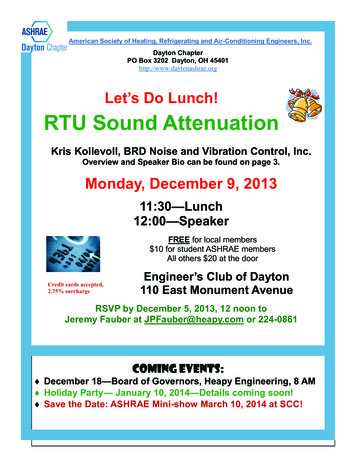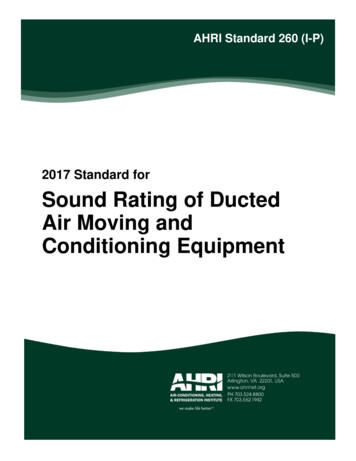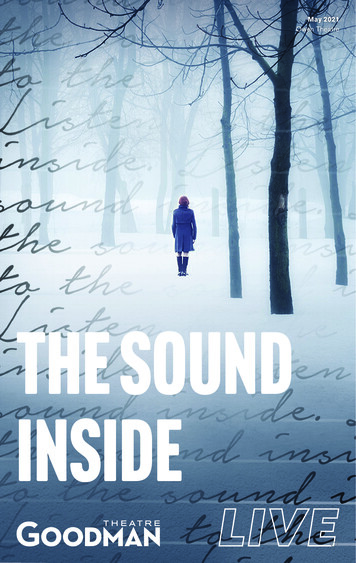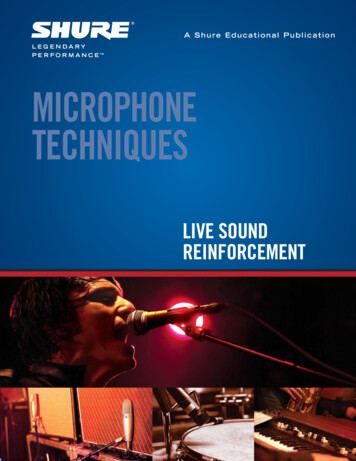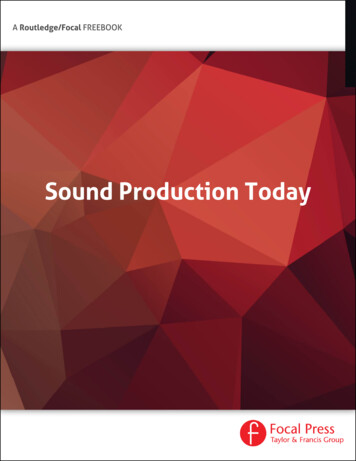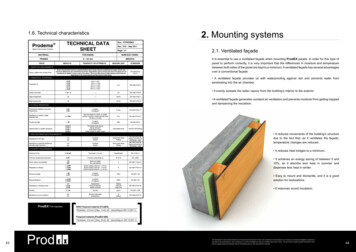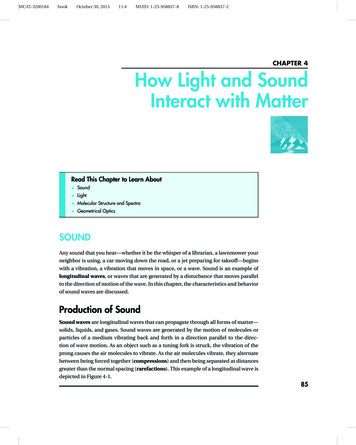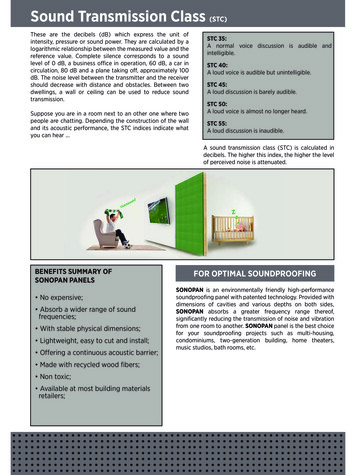
Transcription
Sound Engineering
The Challenge of Sound DesignAn increasing number of automobile manufacturers are identifying a typical sound characteristic for a car or a platform, even a unique„brand sound“ for a whole brand, as a key fea-ture in their product specification. Through thisimage factor that is “sound”, sound design isbecoming increasingly important in exhaustsystem development.The specific importance of tailpipe noiseDiesel and turbo charged enginesThe whole sound profile, particularly that of tailpipe noise, playsDue to its mode of operation, the gasoline engine has a fulleran important role in the subjective impression that a car makes.Customer expectations fall predominantly into two sound types:the ‘limousine’ or ‘saloon car’ sound which is harmonious, quietand discrete whereas the sports car sound demands a morerumbling, rugged aggressive and powerful effect.sound spectrum than the diesel engine. Its dominant engineorders and their sub-harmonics are hardly audible and arezfurther attenuated by the turbo charger. For turbo chargedengines, Tenneco has developed specialised concepts in orderto create a sporty sound using the resonances of the connectingpipes and the muffler chambers in the sound design process.More cylinders, more possibilitiesThe scope for sound design is mainly determined by the number and the arrangement of the cylinders. Due to the increasednumber of main and secondary engine orders, a larger numberof cylinders always results in a broader and fuller sound spectrum. The secondary orders can be amplified by the appropriate design of the manifold and down pipes, without increasingthe total noise level. In addition to the number of cylinders,another effective means of influencing the sound of the engine itself is the targeted tuning of the valve opening times. Afurther sound differentiation can be achieved by modifying theinlet and outlet side of the engine.PerformanceTarget conflictCostsSoundA high performance packageTenneco solves the target conflict Objective determination and specification of thecustomers’ subjective noise requirementsAs a rule, all modifications regarding the sound ofan exhaust system have a negative influence on thetorque- and power output of an engine. Tenneco hasdeveloped a range of concepts to solve this classicaltarget conflict. Efficient use of prediction tools User-specific concepts Cost optimised systems balancing the requirementsfor performance and sound
Methods for Sound DesignEngine management and valve opening timesSymmetricalAsymmetricalBy shifting the valve opening times or by modifying the valvelift profile of at least one of the outlet valves with respect to theremaining outlet valves, it is possible to generate a modulationeffect. This changes the subjective impression considerably,giving it a more sporty sound. To achieve the best possiblesound, Tenneco uses the gas exchange prediction programmesGT Power and WAVE to evaluate and select modifications to valvetiming and opening profiles.Manifold and downpipe designIt is possible to influence the tailpipe noise of an exhaust systemthrough changes to the geometry and layout of its manifold anddownpipes. A sporty sound can be created or enhanced by introducing dissymmetry into the tracts. In manifold design it is thepipes directly adjacent to the cylinder head flange, whereas indownpipe design (in this case a manifold with at least two separate branches is required, i.e. a 4 in 2 in 1 manifold) it is the pipesdownstream of the first Y-piece that are tuned. In the exampleshown above, cylinders one and four exhaust through a long, thinrouting and cylinders two and three through a short, thick routing. This arrangement creates differences in the run times andpressure levels in the two gas flows creating a modulated or uneven sound. In this way it is possible to give the exhaust systemSymmetricalAsymmetricala sportier sound without increasing the overall noise level. Inthe case of a four cylinder engine, the dominant level of the evenengine harmonics (H2 & H4) are slightly reduced whilst that ofthe odd harmonics (H1 & H3) are significantly increased. Theeffect of the dissymmetry in the so-called ‘sound-pipe’ on thepeak power of the engine is within acceptable tolerances. Thepositive effect of the long secondary length of the downpipes isseen in increased torque in the 2000-3000 rpm region. Such a‘sound-pipe’ system can have 10% more torque than a classicalsystem.
Pipe resonancesIn the rear part of the exhaust system it is only possible to influence the sound characteristic through the control of resonancesand the use of damping. The aim, particularly in the case of theturbo-sound, is, to have the level of the harmonics climbingsteadily as engine speed increases with a minimum of peaksand troughs. In the case of a four cylinder engine, the secondand fourth engine orders are key. To achieve this it is necessaryto adjust each pipe length in such a way that no two resonancescoincide in either phase or frequency. Great care is requiredin the layout of, and the flow through the acoustic chambers.Through the use ofprediction tools it isResonance interpretation – „Harmonic corridor“even possible to calculate and tune so-called‘harmonic corridors’.Muffler volume and positionA ‘straight-through’ exhaust is a good starting point when creating an optimum sound for a turbo-charged engine. The volumesused and their positioning, together with optimisation of theiracoustic coupling, are key to achieving a well balanced, sportysound.Turbo conventional systemTurbo sport sound systemResonancesEven harmonicsOdd harmonicsMuffler box internals and valvesValves are also used in the rear part of the muffler system toinfluence the sound characteristics. The SAM valve, developedby Tenneco, can be used both as a semi-active or active controlmechanism. Tenneco has an appropriate valve whatever theapplication demands.
Development Capability – from conceptto customer desired soundA Proven ProcessFor many years Tenneco has been developing innovative solutions to sound-design challenges. The company’s exhaust systems support the brand-typical sound characteristics of manycars in the field today. In close cooperation with the customer,sound patterns are developed at the Engineering Centre in Edenkoben (Germany) which are based on actual sound recordings.In our leading-edge sound studio they are synthetically modifiedto suit the customer’s brand requirements.such as GT Power, P-Cat, Wave, Flowmaster and Star-CD are usedto reduce development time and costs. Tenneco’s customised“GILLAUM” software, enables quick and reliable predictions ofthe specific exhaust system’s tailpipe noise.The foundation provided by the CAE design means that evenearly prototypes are representative of the production solution.The validation and the subjective evaluation of the exhaustsystem takes place either using a test car or one of Tenneco’sIn each development program Tenneco sound specialists workclosely with the customer to first define and then objectivelycharacterise the desired subjective sound profile. After a systematic analysis and rating of the key parameters using Tenneco’sleading edge sound studio an initial proposal is presented to thecustomer.modern engine test benches.After achieving the desired subjective sound profile as wellas fulfilling the other functional requirements specified by thecustomer, including durability prediction, the durability of thedesign is validated using thermal shock tests and manifoldcracking tests on testbeds either at the customer or at Tenneco’stest facilities.Throughout the entire development process, the number ofprototypes and development iterations is reduced to a minimumby the continuous application of CAE programs. Prediction tools1500Realized sport sound systemBase systemTarget sound2500 00 n/rpmDefinition of a targetsound, based onMeasurementa real binauralof a baselinemeasurement.system, binauralanalysis, FFTanalysis, tailpipe noise.450010010005500Gillaum and Waveprediction to maximise the levels ofthe odd harmonics.CAD design andmanufacture ofprototypes.Measurementsof the prototypes(acoustics,back pressure,emissions, power,torque).2000 n/rpmFinal comparisonagainst customerrequirements.Target fulfilled.45005500
Always close to the customer,a global footprintEmission ControlPlantsR&D CenterTenneco is a leading, global developer and manufacturer ofexhaust and ride control systems. Tenneco supplies virtuallyevery top name automotive manufacturer, worldwide.Heinrich Gillet GmbHLuitpoldstr. 83, 67480 EdenkobenGermanyPhone: 49 (0) 6323 47-0Fax: 49 (0) 6323 ase do not hestitate to contact us ifyou require further information.
In the rear part of the exhaust system it is only possible to influ-ence the sound characteristic through the control of resonances and the use of damping. The aim, particularly in the case of the turbo-sound, is, to have the level of the harmonics climbing steadily as engine speed increases with a minimum of peaks and troughs. In the case of a four cylinder engine, the second

